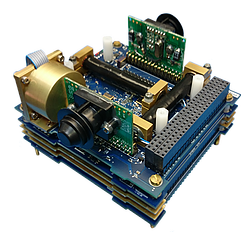Attitude Determination and Control (ADCS)
An Attitude Determination and Control (ADCS) provides measurements regarding a satellite's orbit and allows the satellite to change its inertial position.
Examples of ADCS Hardware
- Most ADCS hardware relies on an ability to change the satellite's position relative to the Earth.
- Reaction wheels: Using small, spinning wheels, reaction wheels allow satellite positioning using the principle of conservation of momentum.
- CubeADCS: CubeSpace's CubeADCS utilizes a variety of sensors (including magnetometers and sun sensors) to accurately determine the satellite's precision. It can use either magnetic torquers (see below) or reaction wheels for attitude determination.
- Magnetorquer: By creating a magnetic field that interact's with the Earth's own magnetic field, a magnetic torquer produces a force that can rotate a satellite.
- Control Moment Gyros: Similar to Reaction Wheels, Control Moment Gyros use a gimbal to change the rotation of a spinning flywheel. See https://www.youtube.com/watch?v=JTWA6tUREi8 for an excellent visual demonstration of CMG technology.
- Thrusters: Though far more uncommon on small satellites, thrusters remain a dependable and conceptually straightforward method of attitude determination.
- Reaction wheels: Using small, spinning wheels, reaction wheels allow satellite positioning using the principle of conservation of momentum.
ADCS Specifications
- ADCS Pointing Accuracy
- ADCS accuracy varies depending on the type and quality of mechanisms and control systems. The popular CubeSpace hardware used on 2U QB50 satellites has an accuracy of 0.2º to 0.6º (keep in mind, however, that the QB50 missions requirements regarding ADCS precision are fairly lax). The BlueCanyon XB1 high precision ADCS suggests an accuracy of 0.002º.
- ADCS Maneuvering Rates
